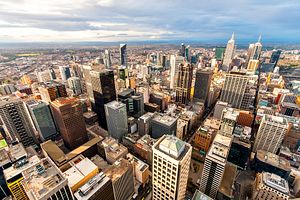On Tuesday night, the Australian federal government delivered its budget for the forthcoming Australian financial year (1 July 2016 – 20 June 2017). The budget contained no dramatic announcements or big concepts. With an election to be held on July 2, and current polls indicating an erosion of its favorability, the conservative coalition government felt an inability to propose dramatic changes.
Yet conspicuously absent from the budget, in an area that would carry weight with the electorate, is a serious commitment to investment in the infrastructure of Australia’s major cities.
When Malcolm Turnbull replaced Tony Abbott as the leader of the Liberal Party last September, and as a result as Prime Minister, in his cabinet reshuffle he created a Minister for Cities and the Built Environment.
This was seen as a major shift in perspective within the government toward recognizing the importance of cities to the country’s future, as well as the realities of 21st Century human organization: hyper-connected cities. However, the minister appointed to the role was forced to resign within three months, due to inappropriate behavior towards a female staffer, and has yet to be replaced.
This greater engagement towards the concept of the city was fleeting, caught up in a wave of grand ideas Turnbull wished to pursue. But Turnbull leads a party not on fully on board, and suffers from what seems to be a short attention span; he has failed to commit to developing Australia’s urban spaces. And this was confirmed with the budget figures the government has presented.
Australia continues to grow by around 300,000 people a year. Economist Tim Colebatch recently provided a breakdown of Australia’s population growth, and the urban dominance of this growth.
He notes that 76 percent of Australia’s population growth went to to the four biggest cities of Sydney, Melbourne, Brisbane and Perth. With 29 percent in Melbourne and 26 percent in Sydney. An indication that Australia is not on rapidly urbanizing (it is already a highly urban country), but its two main cities continue to be the main beneficiaries of this growth.
Melbourne, the capital of Victoria state, remains Australia’s second largest city, but its rapid growth will see it surpass Sydney in the near future. However, the budget has allocated a disproportionately low amount of infrastructure funds to the state of Victoria, itself Australia’s second largest.
For the coming financial year, the government promises to spend just $328 million in Victoria on infrastructure projects, compared to $2.7 billion in New South Wales, $1.6 billion in Queensland, and more than $1 billion in Western Australia.
With NSW and Queensland set to be the battleground states for the election this makes some kind of petty political sense, but it also seems to indicate a massive blind-spot in responsible governance. Australia’s increasingly centralized federation makes it difficult for the states to fund their infrastructure requirements by themselves.
The Victorian State government has committed to building the inner-city Melbourne Metro project, and has begun significant works in decoupling railway lines from the burden of intersecting with roads. However, both these measures are reactionary to current capacities. There is almost no vision towards creating much needed new transport links throughout the city and its sprawling, low-density, car-reliant, suburbs.
Yet, the Melbourne metropolitan rail network has had almost the same suburban reach since the 1930s, when the city was a quarter of its current size.
When federal government infrastructure spending is allocated, it is now tied to overwrought planning projections, with targets set for job creation, housing construction and other economic indicators. A top down and meddlesome form of city building that runs counter to accepted urban theory about cities being self-directed entities that flourish best when undirected.
This understanding of cities, and what they need and don’t need from the state, will be one of the essential concepts for the Australian government to grasp in the coming decades. Particularly as modern economic incentives continue to push people towards urban living.
The perspective of the current Australian government remains the great paradox within modern conservative parties (and a source of their current disquiet); they maintain a firm commitment to the great gains of global free trade, but fail to both fathom and acquiesce to the grand changes that the freer movement of goods, services, people and ideas brings.
Without prioritizing intelligent infrastructure spending in its major cities, Australia will hinder its ability to create the modern innovative society that the prime minister claims is his vision.

































